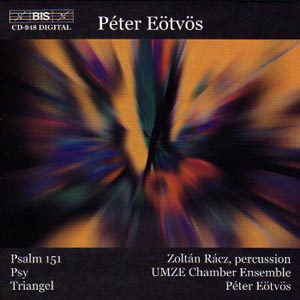Triangel
Percussion concerto
Commissioned by Musik der Jahrhunderte Stuttgart
Description
First performance: February 1994 Stuttgart
Junges Philharm. Orch. Stuttgart
Conductor: Manfred Schreier
Isao Nakamura, perc.
“Musical action play for a creative percussionist and 27 instruments. ”
It seems to me that solo percussionists have their own little universe: they have instruments they prefer special playing techniques that differentiate them from other percussionists. Triangel is composed in a way that space is provided for these individual creative forces. The ensemble, which is divided into four groups, reacts partly in a fixed manner, partly spontaneously to the music coming from the soloist. This piece rediscovers the improvised cadence techniques, which were an inherent part of concertos about 100 years ago.
/Peter Eötvös – 1999/
Synopsis
Triangel has 10 movements, each with its own individual character.
Entry with triangle (solo)
First Promenade – masculine (ensemble)
On the wooden street (woodwinds and plate bells)
Second Promenade – feminine (ensemble)
Expansion / Contraction (strings and steeldrums)
Semi-finale (tutti- and a bass timpano)
Metallic sounds (brass instruments, tam-tam and gongs)
Triangle choirs (24 tutti- und 3 solo triangles)
Dervish Dance (clarinets- solo and 3 amplified triangles)
Exit with triangle (solo)
Performances
Eötvös: Triangel
Concerto Orchestra
Isao Nakamura, percussion
Müpa Budapest
Eötvös: Triangel
Janacek Academy Orch.
Cond: Zsolt Nagy
Laszlo Hudacsek perc. solo
Eötvös: Triangel, Snatches of a conversation
Eötvös: Triangel
Amaral: Paraphrase
Eötvös: Snatches of a conversation
Messiaen: Oiseaux exotiques
Birtwistle: Cantus Iambeus
Cond: Peter Eötvös
London Sinfonietta
Gulbenkian Foundation
Eötvös: Triangel, Snatches of a conversation
Eötvös: Triangel
Amaral: Paraphrase
Eötvös: Snatches of a conversation
Messiaen: Oiseaux exotiques
Birtwistle: Cantus Iambeus
Cond: Peter Eötvös
London Sinfonietta
Gulbenkian Foundation
Eötvös: Triangel, Replica, Snatches of a conversation
Netherlands Radio Chamber Orchestra
Cond: Peter Eötvös
Eötvös: Triangel, Snatches of a conversation, Replica
Budapest Spring Festival
Eötvös: Triangel, Snatches of a conversation, Replica
Michael van der Aa: Here
Kim Kashkashian, viola
Cond: Peter Eötvös
Thalia Theatre Budapest
Eötvös: Triangel
Cond: Kwamé Ryan
Theater Freiburg
Eötvös: Triangel
Cond: Kwamé Ryan
Theater Freiburg
Eötvös: Triangel
UMZE Chamber Ensemble Budapest
Cond: Peter Eötvös
Eötvös: Triangel, Steine
Ensemble InterContemporain
Cond: Peter Eötvös
Eötvös: Triangel, Steine
Ensemble InterContemporain
Cond: Peter Eötvös
Eötvös: Triangel
Musica festival
Ensemble InterContemporain
Eötvös: Triangel
Berlin Akademie der Künste, Germany
UMZE Budapest
Eötvös: Triangel
UMZE Chamber Orchestra
concert, radio rec.
Eötvös: Triangel
Junges Philharm. Orch
Isao Nakamura-perc.,
cond.: Manfred Schreier
Details
Publisher information
Edition Ricordi München (Sy 3212)
https://www.ricordi.com/en-US/Catalogue.aspx/details/441390
Orchestration

2.2.2 (bcl).2./2.2.2.1./2 perc./electr. piano/3.0.3.2.1
Technical information
As a composer, Peter Eötvös wanted to give a solo percussionist the opportunity to find his own voice and to show off with his technical skills, musical experience, his imagination in sound and rhythm. What a composer can offer a solo percussionist is often very limited compared to what soloists themselves are able give themselves. The composer only creates the basic framework of the piece, the big picture and allows the soloist to move freely within its constraints. The piece does not consist merely of improvisation though; the pre-composed and improvised materials are treated equally.
The soloist works with four groups of instruments:
– 8 woodwinds,
– 6 brass instruments + tuba
– 9 strings
– a small background group with a keyboard and two modestly set up percussion instruments (+ tuba).
The soloist and the four instrumental groups are in mutual interaction with each other: the soloist plays a tune, the groups follow and respond in the own ways; then the soloist has to integrate the musicians’ reactions back into his music. The constant obligation to listen is a typical feature of Triangel; a communication comes to a life – as we know it from African folk music -, in which the musician interacts with the “people”. Only the movement “Semi-final” prescribes accurately what the soloist has to do.
The piece consists of different movements; each movement has its own individual character, which is emphasised by characteristic lighting effects.
Sound
Recordings
Further information
This “action piece” composed in 1993 is not the kind of concerto where the soloist is accompanied by an ensemble. Here the percussionist is a leader, a “master drummer” of the African sort, and the other instruments are the “people”, who react and respond.
Triangel gives the solo percussionist the opportunity to demonstrate his instrumental and musical experience, his imagination in rhythm and sound.
The piece also makes the percussionist co-composer, as the parts are set down in writing and those improvised by the soloist are treated equally. It is also an exercise of listening and responding, as the percussionist does not only dictate but also responds to the reactions of the “people”.
Triangel has 10 movements, each with its own individual character.
